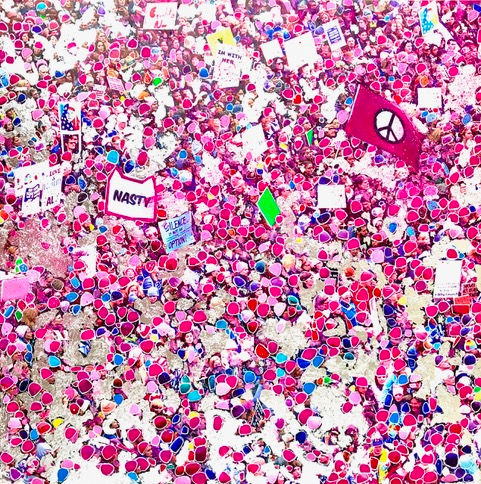Battling in pink: an interview with Yumiko Hirokawa
- Alessandro Berni

- Dec 6, 2019
- 3 min read
The power of the color pink came into full display with the pink pussy hats of the 2017 Women’s March in Washington, DC, overtaking the city just a few months before the iconic cherry blossoms flowered for the spring.

Flags, 2019
There is a long history of the color pink and floral motives being intrinsically tied with femininity, and often fertility, that artists tend to either shy away from or oppose in their work. Yumiko Hirokawa does the opposite. When first viewing her work, it is natural for thoughts to turn to the cherry blossoms found both in her past life in DC and her current Japan. The dots resemble petals scattered across the piece, almost caught mid movement as they swirl through. The anger or heaviness of the protests isn’t present, but doesn’t make this work any less emotive. Hirokawa’s paintings have a feel of a memory emerging from one’s consciousness, appearing in the haze with vivid clarify. As an immigrant using to live in the political capital of the United States, a hotbed for so many of the issues artists are attempting to currently trying to tackle in their work, Hirokawa offers a bright and engaging perspective that captures and remains with the viewer.
Your paintings from the Women's March look like the flowers of the cherry blossoms, both in DC and Japan. Did you do this on purpose or was it a coincidence? For me, the women's march in Washington DC was a very beautiful demonstration. So I wanted to draw like a cherry blossom in Washington DC. I think my Japanese identity has linked women's march and cherry blossoms. I grew up in Kyoto, so when I was painting, the pink flow often doubled with the image of a geisha's hair accessory.
What would you like the viewer to take away and learn from one of your paintings? I want the viewers to get the energy to stand up, look forward, and keep walking, no matter what difficulties they see by looking at my pictures And since I think that women's march in 2017 should be handed down to the next generation, I want my painting to help it.

Flags, 2018
What was it like living in DC as an artist and as an immigrant in those highly political time? Did it inspire your work or make it harder? I think living in the political city of Washington has really influenced my work. I graduated from the Corcoran College of Art and Design which is close to the White House. And when I was in college, 9/11 happened and I have really been shocked by that. I realized now that 9/11 made a deep impression on me and became the guiding inspiration for my work. My work embodies two pillars: one is a record of a moment in modern society and the other is a prayer for the many people who have suffered from disasters and conflicts around the world.
What did you love about living in Washington DC? What is the artist community like? I really like living in Washington, DC. There are a lot of foreigners and I can come in contact with various ideas coming from various backgrounds, which will make my heart very wide.The art community in Washington DC is very nice. It is neither too big nor too small which as a foreigner was the ideal condition.
What are you trying to achieve in your work? Are you trying to capture a moment? I regard the demonstrators as present-day freedom fighters, I want to draw them like heroes and heroines in classical paintings, who live desperately even in difficult situations. I was drawing a picture of a refugée boat before the series of women’s march. I wanted the refugées to demonstrate like that. I think they also are present-day freedom fighters.

#Resist, 2019
What does #Resist represent to you? I looked at many signs of the women's march as I drew the picture. It was this sign that most affected me. “#” is a symbol of connection, to “Resist” together the contraddiction of modern society. Compared to Americans, Japanese people are a silent majority. I came to America and realized that #resisting was very important.
As an artist, you participate to a lot of Art Fairs. This autumn you made both Washington and New York, returning to Clio: what is it like being a part of Clio Art Fair? What do you like about it?
I have been participating in the Clio Art Fair for 3 years. They are a great organization, they are warm and passionate, and I always feel at home. The policy of supporting their independent artists is amazing. I learned a lot in this art fair. I am very grateful to them, and I always make connections during Clio Art Fair.


Comments